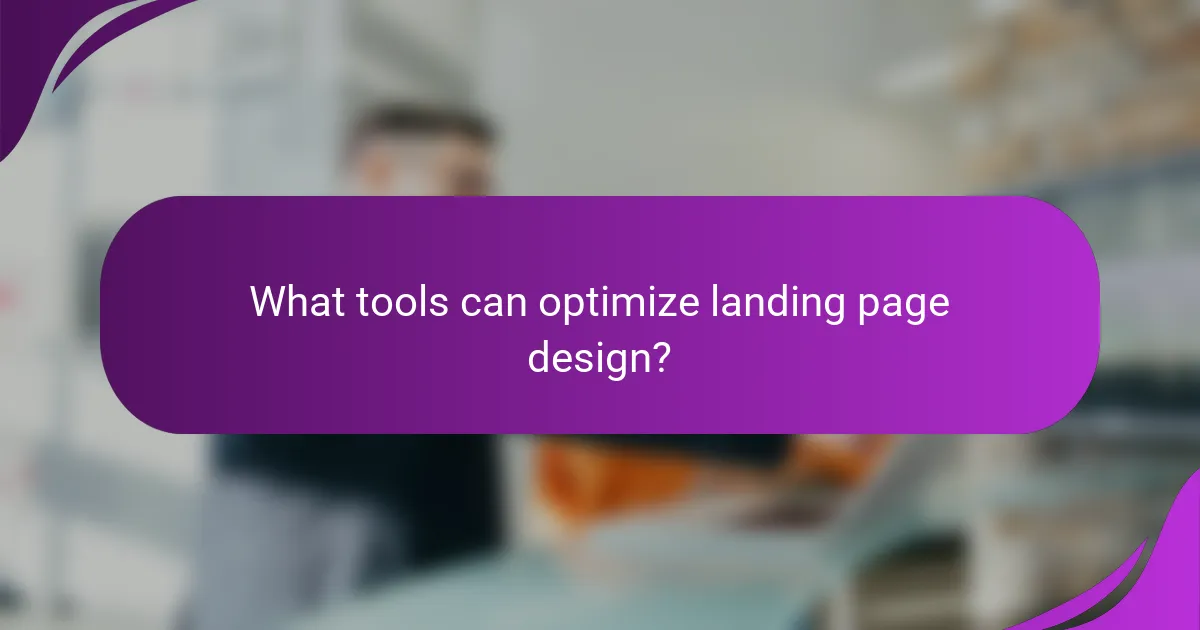Creating effective landing pages requires a strategic approach that emphasizes clarity, user experience, and conversion optimization. By focusing on visual hierarchy, compelling copy, and well-placed calls-to-action, you can significantly enhance visitor engagement and drive desired actions. Key elements such as strong headlines, clear value propositions, and emotional triggers play a vital role in capturing attention and fostering conversions.

How to design effective landing pages in the UK?
To design effective landing pages in the UK, focus on clarity, user experience, and conversion optimization. Prioritize elements like visual hierarchy, mobile responsiveness, and brand consistency to engage visitors and encourage them to take action.
Visual hierarchy and layout
Visual hierarchy guides users through your landing page, emphasizing key elements like headlines and calls-to-action (CTAs). Use size, color, and placement to draw attention to the most important information first.
Consider a layout that leads the eye naturally from the top to the bottom of the page. For example, a large, bold headline at the top, followed by a brief description, and a prominent CTA button can effectively capture attention.
Mobile responsiveness
With a significant portion of traffic coming from mobile devices, ensuring your landing page is mobile-responsive is crucial. This means it should adapt seamlessly to various screen sizes without losing functionality or aesthetic appeal.
Test your landing page on multiple devices and browsers to ensure that buttons are easily clickable and text is legible. A responsive design can improve user experience and increase conversion rates significantly.
Brand consistency
Maintaining brand consistency across your landing page reinforces your identity and builds trust with visitors. Use your brand’s colors, fonts, and tone of voice consistently throughout the page.
For example, if your brand uses a specific shade of blue, ensure that all buttons and headings reflect this color. This not only enhances recognition but also creates a cohesive look that can lead to higher engagement.
Use of whitespace
Whitespace, or negative space, is essential for creating a clean and uncluttered landing page. It helps to separate different elements and makes the content easier to digest.
Aim for a balanced layout where text, images, and CTAs have enough space around them. This can help guide the user’s focus and make the page feel less overwhelming, ultimately improving conversion rates.
High-quality images
Using high-quality images can significantly enhance the visual appeal of your landing page. Images should be relevant, professional, and optimized for fast loading times to avoid frustrating users.
Consider using images that reflect your product or service in action. For instance, if you are promoting a travel service, vibrant images of destinations can evoke emotions and encourage users to engage further.

What copy elements enhance landing page effectiveness?
Effective landing pages rely on specific copy elements that capture attention and drive conversions. Key components include compelling headlines, clear value propositions, concise body text, emotional triggers, and testimonials or social proof.
Compelling headlines
Compelling headlines are crucial for grabbing visitors’ attention immediately. They should be clear, engaging, and relevant to the target audience’s needs or interests. Aim for headlines that convey a strong benefit or evoke curiosity.
For example, instead of a generic “Welcome to Our Site,” use “Unlock Your Potential with Our Expert Coaching.” This approach not only attracts attention but also sets the tone for the rest of the content.
Clear value propositions
A clear value proposition explains why a visitor should choose your product or service over competitors. It should succinctly outline the unique benefits and features that address the audience’s pain points. Use straightforward language and avoid jargon.
For instance, a value proposition like “Save 30% on Your Energy Bills with Our Smart Thermostat” directly communicates the advantage, making it easy for visitors to understand the offer’s worth.
Concise body text
Concise body text is essential for maintaining reader engagement. Use short paragraphs and bullet points to break down information into digestible chunks. Focus on the most important details that support the headline and value proposition.
Avoid lengthy explanations; instead, aim for clarity and brevity. For example, instead of writing a long paragraph about features, list them with brief descriptions: “Energy-efficient, user-friendly, and customizable settings.”
Emotional triggers
Emotional triggers can significantly influence decision-making. Incorporate language that resonates with your audience’s feelings, such as fear of missing out (FOMO), happiness, or security. This connection can motivate visitors to take action.
For example, using phrases like “Join thousands of satisfied customers” or “Don’t miss out on our limited-time offer” can create urgency and encourage conversions.
Testimonials and social proof
Testimonials and social proof build trust and credibility. Displaying positive feedback from satisfied customers or endorsements from industry experts can reassure potential buyers about their decision. Include specific details that highlight the benefits experienced by previous users.
Consider using a format like: “I saved over $500 in my first year!” This not only provides evidence of effectiveness but also makes the offer more relatable to new visitors.

What are the best practices for calls-to-action?
Effective calls-to-action (CTAs) are crucial for guiding visitors toward desired actions on landing pages. Best practices include using action-oriented language, ensuring visibility and placement, leveraging color psychology, and creating a sense of urgency or scarcity.
Action-oriented language
Using action-oriented language in your CTAs encourages users to take immediate steps. Phrases like “Get Started,” “Download Now,” or “Join Free for a Month” clearly communicate the action you want the user to take.
Keep the wording concise and direct. Avoid vague terms; instead, use strong verbs that convey confidence and clarity. For example, instead of saying “Learn More,” consider “Discover Your Solution” to evoke curiosity.
Visibility and placement
CTAs should be prominently placed on the landing page to catch the user’s eye. Position them above the fold, where users can see them without scrolling, and repeat them at strategic points throughout the page.
Consider using contrasting colors or bold fonts to make your CTAs stand out. A common practice is to place a primary CTA in a fixed position on the screen, ensuring it remains visible as users navigate through the content.
Color psychology
The colors used in your CTAs can significantly impact user behavior. Different colors evoke different emotions; for example, red can create urgency, while green often signifies safety and trust.
Choose colors that align with your brand while ensuring they contrast with the background for visibility. Testing various color combinations can help determine which ones resonate best with your audience.
Urgency and scarcity
Creating a sense of urgency or scarcity can motivate users to act quickly. Phrases like “Limited Time Offer” or “Only 3 Spots Left” encourage immediate responses by tapping into the fear of missing out.
Incorporate countdown timers or limited availability notices to reinforce this urgency. However, ensure that these tactics are genuine to maintain trust with your audience and avoid misleading claims.

How to measure landing page performance?
Measuring landing page performance involves analyzing various metrics that indicate how well the page converts visitors into leads or customers. Key performance indicators (KPIs) such as conversion rates, A/B testing results, and user engagement metrics provide insights into the effectiveness of your landing page design and copy.
Conversion rate tracking
Conversion rate tracking is essential for understanding how many visitors complete the desired action on your landing page. This is typically calculated by dividing the number of conversions by the total number of visitors, then multiplying by 100 to get a percentage. A good conversion rate can vary widely by industry but generally falls between 2% and 5%.
To effectively track conversion rates, use tools like Google Analytics or dedicated landing page software. Set clear goals for what constitutes a conversion, whether it’s a purchase, sign-up, or download, and ensure that tracking is properly configured to capture this data.
A/B testing results
A/B testing involves comparing two versions of a landing page to determine which performs better. By changing elements such as headlines, images, or call-to-action buttons, you can gather data on user preferences and behaviors. Aim for a statistically significant sample size to ensure your results are reliable.
When conducting A/B tests, focus on one variable at a time for clearer insights. Monitor the performance over a set period, ideally a few weeks, to account for variations in traffic and user behavior. Analyze the results to inform future design and copy decisions.
User engagement metrics
User engagement metrics provide insights into how visitors interact with your landing page. Key metrics include bounce rate, time on page, and scroll depth. A lower bounce rate and longer time spent on the page typically indicate that users find the content relevant and engaging.
To improve user engagement, consider using heatmaps or session recordings to observe user behavior. This data can help identify areas of the page that may need adjustments to keep visitors interested and encourage them to convert. Aim for a bounce rate below 40% for optimal engagement.

What tools can optimize landing page design?
To optimize landing page design, various tools can enhance aesthetics, functionality, and user experience. These tools range from design software to analytics platforms that help track user behavior and engagement.
Design Software
Design software like Adobe XD, Sketch, and Figma allows you to create visually appealing layouts and prototypes. These tools offer features such as drag-and-drop interfaces, collaboration options, and integration with other applications, making it easier to design and iterate on landing pages.
When choosing design software, consider factors like ease of use, compatibility with your existing tools, and the ability to share designs with team members. A good design tool can significantly streamline the design process and enhance creativity.
A/B Testing Tools
A/B testing tools, such as Optimizely and VWO, enable you to compare different versions of your landing page to see which performs better. By testing variations in headlines, images, or call-to-action buttons, you can gather data on user preferences and optimize for higher conversion rates.
Implement A/B testing regularly to refine your landing page. Aim for a statistically significant sample size to ensure reliable results. Avoid making too many changes at once, as this can complicate the analysis of what worked.
Analytics Platforms
Analytics platforms like Google Analytics and Hotjar provide insights into user behavior on your landing page. They help track metrics such as bounce rates, time on page, and conversion rates, allowing you to identify areas for improvement.
Utilize these analytics to make data-driven decisions. Set up goals in your analytics platform to measure specific actions, such as form submissions or purchases. Regularly review the data to adapt your landing page strategy based on user interactions.
Content Management Systems (CMS)
Content Management Systems, such as WordPress or HubSpot, facilitate easy updates and management of landing page content. These platforms often come with built-in templates and plugins that can enhance design and functionality without needing extensive coding knowledge.
Choose a CMS that aligns with your technical skills and offers the features you need. Consider factors like SEO capabilities, mobile responsiveness, and integration with marketing tools to ensure your landing page is effective and user-friendly.
